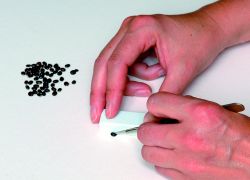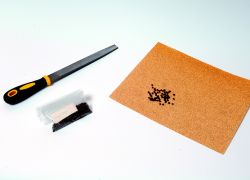Examples: Broom, gorse, false-acacia, laburnum, tree lupin
Tropical legume trees – Acacia species, Leucaena leucocephala
All these seeds possess a thick, impermeable seed-coat which prevents or significantly retards germination. Pretreatment consists of removing, puncturing, abrading, splitting, burning or softening the hard seed-coat – without damaging the embryo within. These are the only tree seeds which do not need to be moist to respond to pretreatment.
 Hold seed down with an eraser. Use sharp knife / scalpel to chip away small section of seed coat without cutting embryo. Wear safety spectacles.
Hold seed down with an eraser. Use sharp knife / scalpel to chip away small section of seed coat without cutting embryo. Wear safety spectacles.

Pour 3 to 10 volumes of boiling / hot water on 1 volume of seeds. Allow seeds and water to cool for 18-24 hours.

Use abrasive paper to remove a small section of the seed-coat.

Make a small hole in the seed coat with a soldering iron or a hot instrument taken from a fire.